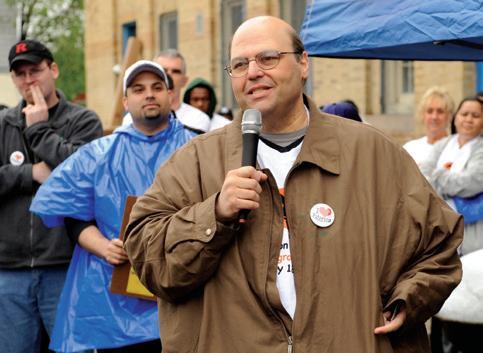2 minute read
Executive Summary
Great Falls Neighborhood Snapshot
Language Other Than English Spoken At Home of Total Population (Spanish: 49.1%; “Indo-European” [Bangladeshi]: 23.1%)
(Source: 2015-2019 US Census American Community Survey Five-Year Estimates)
Summary of Goals and Strategies
Goal 1. Empowered Community
Strategy 1.1 Conduct Effective and Empowering Community Organizing
Community organizing is essential to creating a truly empowered community. This strategy looks to create a broader, more focused and structured community organizing program, that will be integrated into all of NJCDC’s activities.
Strategy 1.2 Support Resident-Led Community Initiatives
An empowered community is able to take direct initiative to improve the neighborhood through organizing projects and other community-improvement efforts. This strategy supports residents in carrying out these types of projects and efforts, including trash clean ups, beautification projects that plant trees or apply fresh paint to eyesores, or resident-organized block parties that bring neighbors together.
Strategy 1.3 Continue and Enhance the Neighborhood Help Center as a Community Hub

This strategy expands the reach and impact of the Neighborhood Help Center. The Center will extend its hours and open satellite sites. The Center will also increase its service offerings to place greater focus on community organizing and immigrant integration as well as financial literacy and budgeting.

Strategy 1.4: Improve Public Safety
Great Falls residents identify public safety as an especially salient community issue. Starting from the goal and value of an empowered community, this strategy will prepare neighborhood residents to address public safety issues, by working directly with the police, City officials, and other residents employing a diverse set of tactics.
Goal 2. Neighborhood Revitalization

Strategy 2.1: Support Local Businesses and Commercial Corridors

The Great Falls Neighborhood has a number of retail and restaurant corridors that serve the community by providing residents with groceries, personal services, and other consumer needs. This strategy will help strengthen local businesses both individually and collectively, by connecting businesses to resources and capital, enhancing the look and feel of retail districts, and joint marketing efforts to attract visitors.
Strategy 2.2: Promote Tourism Opportunities Created by the National Park to Spur Economic Development and Revitalization
The Great Falls National Historical Park is a tremendous neighborhood asset that brings visitors from around the country into the Great Falls Neighborhood on an almost daily basis. However, the neighborhood is not yet fully capturing the potential economic benefit of the National Park. This strategy seeks to better position the neighborhood to realize these economic benefits while also enhancing the options and experience of visitors to the National Park.

Strategy 2.3 Improve Parks and Recreational Assets
There are a number of other parks and recreational assets in the neighborhood that suffer from underutilization and are in significant need of improvement. This strategy looks to improve quality of life for neighborhood residents and give them more opportunities for living healthy lifestyles by making these improvements and upgrades to the neighborhood’s parks and green spaces so that they are inclusive, healthy places.

Strategy 2.4 Help Residents Access and Create Good Jobs
Despite working consistently, Great Falls residents generally earn relatively low wages. Helping residents access higher wage jobs has major potential to transform the neighborhood. This strategy seeks to achieve this through education and training, partnerships with employers, and labor rights organizing.
Strategy 2.5 Facilitate Large-Scale, Strategic Economic Development Projects at Key Neighborhood Sites
With the neighborhood attracting tremendous levels of investment and development, community leaders have an important role to play in helping to define and facilitate future large-scale economic development projects in the neighborhood. This strategy aims first to cultivate and maintain a policy and planning environment that promotes positive, equitable redevelopment.
Strategy 2.6: Implement and Improve Pedestrian and Bicyclist Safety Infrastructure
Given its density, the Great Falls Neighborhood has great potential to be a walkable, bikeable neighborhood. Unfortunately, the neighborhood currently lacks critical pedestrian and cycling safety infrastructure to fully achieve this potential. This strategy looks to change that.









